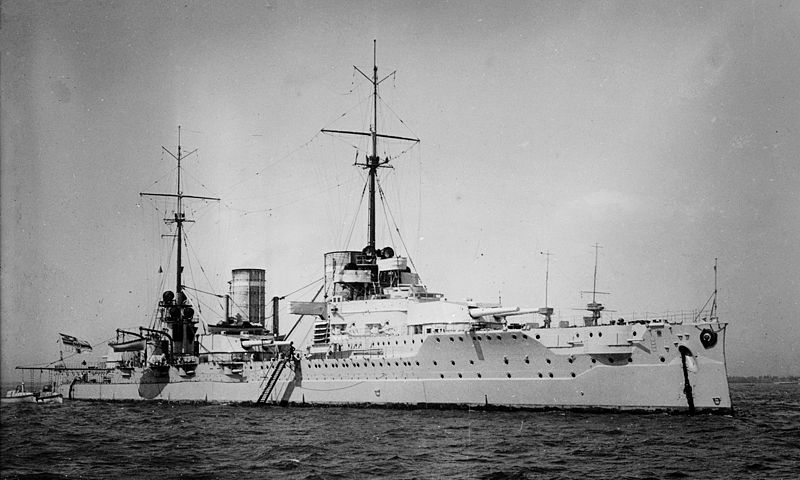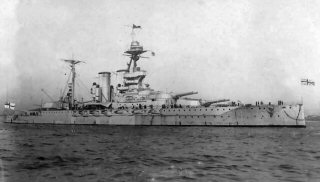|
|
|
|
|
|
|
BATTAGLIA NAVALE DELLO JUTLAND
NAVAL BATTLE OF JUTLAND
|
|
|
|
|
|
|
31 MAGGIO 1916 - 1° GIUGNO 1916


STORIA / HISTORY
LA FUGA RIUSCITA DI SCHEER /
THE SUCCEDED ESCAPE OF ADMIRAL SCHEER
Alle 21.14 l'Ammiraglio Scheer ordinava per radio "rotta sud-sud-est una quarta est; velocità 16 nodi". Questo significava far traversare alla cieca la formazione nemica: era un rischio che doveva assolutamente esser corso.
Alle 22.30 un gruppo di esploratori tedesco entrava in contatto con una squadra di incrociatori leggeri britannici. Il vecchio incrociatore tedesco Frauenlob colpito da un siluro affondava, mentre due unità inglesi Dublin e Southampton venivano seriamente colpite. Un'ora dopo era il grosso della flotta germanica ad attraversare una formazione di cacciatorpediniere nemci, alcuni dei quali venivano messi fuori combattimento sia dal fuoco tedesco, sia dalle collisioni con le navi più grosse. Poco dopo la mezzanotte l'incrociatore corazzato inglese Black Prince, trovandosi improvvisamente a ridosso delle corazzate di von Scheer, veniva fulmineamente affondato da una bordata del Thuringen (i tedeschi credettero di aver distrutto l'Eurydalus).
L'ultimo scontro avvenne alle 2.10 quando il vecchio incrociatore tedesco Pommern fu affondato da un siluro.Soltanto verso le 2.30 la sua armata comprese la gravità della situazione ed effettuò una conversione in direzione nord-ovest, ma era troppo tardi, in quanto la flotta tedesca, già passata a babordo e col sopraggiungere del giorno, era sparita per fare rotta verso Jadebusen e Wilhemshaven.
La battaglia dello Jutland, chiamata dagli storici tedeschi dello "Skagerrak", era finita. Passando per i corridoi sgombri dalle mine a sud di Horn Riffs, la flotta germanica rientrava nelle sue basi; quella inglese, all'altezza del 55° parallelo, invertiva la rotta e una volta rastrellate le acque del combattimento in cerca di eventuali unità nemiche rimaste sparate dal grosso della formazione, faceva rotta verso i porti di casa.
THE SUCCEDED ESCAPE OF ADMIRAL SCHEER
At 21.14 o'clock the admiral Scheer ordered for radio "south-south-east rout a fourth grade east; speed 16 knots." This meant to make to cross to the blind one the hostile formation: it was a risk that absolutely owed to be raced.
At 22.30 o'clock a German group of explorers came into contact with a team of British light cruisers. The old German cruiser Frauenlob struck by a torpedo sank, while two unities English Dublin and Southampton came seriously stricken. A hour later it was the big one of the Germanic fleet to cross a formation of destroyer nemci, some of which you/they were put out fight both from the German fire, and from the collisions with the biggest ships. Shortly after the midnight the cruiser armored English Black Prince, suddenly finding itself behind the battleships of von Scheer, fulmineamente it came sunk by a broadside of the Thuringen (the German credetteros to have destroyed the Eurydalus).
The last clash happened at 2.10 o'clock when the old German cruiser Pommern was sunk by a torpedo.
The battle of the Jutland, called by the German historians of the "Skagerrak", it was ended. Passing for the clear of corridors from the south mines of Horn Riffs, the Germanic fleet it reentered in his/her bases; that English, to the height of the 55° parallel, it reversed the rout and once you rake up the waters of the fight looking for possible remained hostile unities shot by the big one of the formation, it made rout toward the harbors of house.
LE PIU' GRANDI BATTAGLIE NAVALI (NAVAL BATTLES)
BATTAGLIA NAVALE DELLO JUTLAND / JUTLAND NAVAL BATTLE
PORTAEREI NELLA STORIA (AIRCRAFT CARRIERS)
NAVI DA GUERRA (WARSHIPS AND BATTLESHIPS)